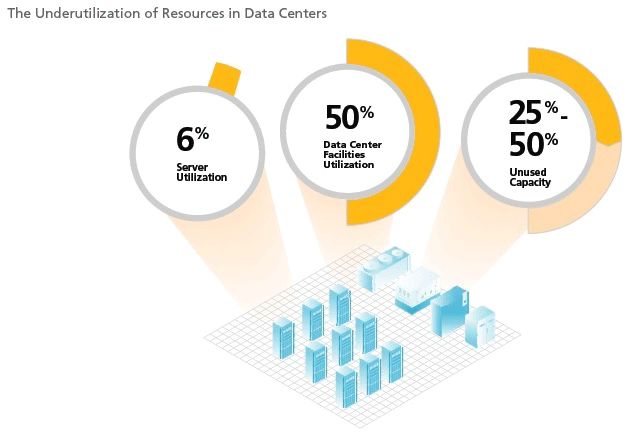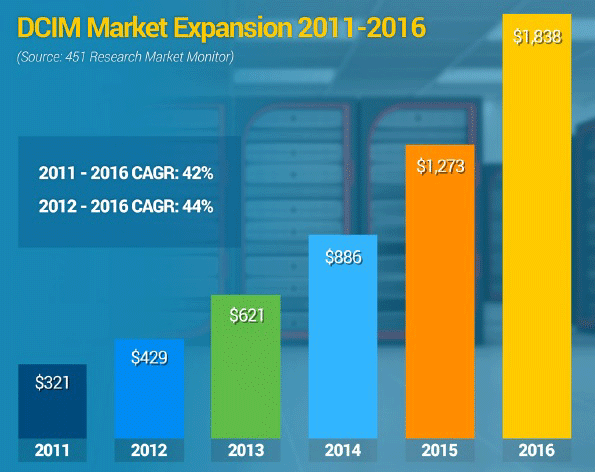The Need for Advanced Asset Tracking in Data Centers
Manual spreadsheets and Visio diagrams are a thing of the past. Today’s dynamic data centers require an equally dynamic asset tracking software to improve efficiency and reduce costs
There’s so much movement of equipment in data centers that over a period of time, it becomes extremely challenging to track where every asset is located. With frequent adds/moves/changes, equipment tends to get displaced and difficult to track over a period of time. This leads to substantial loss of productivity, a huge amount of unused capacity due to over-provisioning of resources, and of course, increased cost of data center management.
According to a McKinsey study, servers in data centers are used at just 6% of their capacity, while overall data center facilities are utilized at 50% of their rated capacity. This is not surprising, because there’s greater focus by the management on ensuring 100% uptime for customers than hunting for lost capacity. So it would not be uncommon, for instance, to see equipment that’s still under warranty getting de-commissioned unknowingly, while the management puts fresh requisitions for a multi-million dollar purchase of fresh equipment. It’s easier to purchase fresh equipment than trace lost equipment inside the data center.

Software inventory adds another dimension of complexity in data center management because it moves along with the devices. As a result, you might end up purchasing additional licenses for software that you already possess licenses for.
Manpower attrition can lead to further delays and costs, if you haven’t implemented a proper asset tracking solution.
Therefore, there is a dire need to have a proper asset tracking solution for data centers, which can help recover lost capacity, improve productivity, and help the organization save a considerable amount of cost. This is possible by implementing a DCIM (Data Center Infrastructure Management) solution.
Elements of an Ideal DCIM Solution
Knowing what you have in your data center and where it is kept can be a complex task because you have both operational and non-operational components to keep track of. Finding out which assets are operational, where are they located, and how are they configured is easier said than done.
Even though technologies like RFID tags can easily track equipment, they are impractical in data centers because of the sheer number of equipment of all sizes, and of course, software assets that can’t be tracked with RFID.
A data center asset tracking solution should therefore be a combination of software and hardware to keep track of everything along with their operational status. It falls under the Data Center Infrastructure Management (DCIM) solutions category, which is growing at a rate of 40% CAGR with an annual revenue of close to a billion dollars (according to 451 Research Market Monitor).

Here’s what to look for in an ideal asset tracking solution.
It should track everything: Whether it’s power, network, patch panels, data connectivity, IT equipment like servers and storage, or even applications, a data center asset management software should be able to track everything, and that too in real time.
The more the number of assets it can track, the better. It eliminates the need for using multiple software for asset tracking, like Excel sheets, diagram creation software like Visio, etc.
It should provide visual mapping: Besides tracking everything, it should give a visual mapping of all assets, how they are connected and related to each other, what applications are they running and the services they are providing. This is extremely important to be able to pinpoint the location of a particular equipment with precision.
Colored rack PDUs, for instance, provide another sort of visual mapping, which makes it easy to identify and work on. You can simply tell a technician for instance, to work on the blue PDUs and not to touch the red ones. This will ensure higher uptime of equipment, and reduce downtime due to human error.
It should track software too: Besides using software to identify assets, advanced asset tracking software can also assign digital IDs to various assets, and even put sensors on them. Raritan, a company known for Data Center Infrastructure Management solutions for instance, has such a feature in its solution. The digital IDs let you remotely track all equipment with complete provision, while sensors can raise an alert the moment any equipment is displaced from its current position.
Benefits of Using an Asset Tracking Solution
Using a comprehensive asset tracking solution for your data center helps data center managers ensure continuity of service, reduce their CapEx and OpEx spends, and meet their capacity needs.
Improve productivity and reduce time: There are several benefits of using such advanced asset management software in data centers. One, you can easily find where a device is located, which speeds up management tasks like provisioning new equipment, upgrading older one, etc. Your staff no longer needs to be inside the data center to track equipment because everything can be accessed remotely.
Better capacity planning: Secondly, it helps in capacity planning of a data center, which is a serious concern for most data center managers because both under or over-provisioning is extremely unhealthy for a data center. By knowing the asset details and their physical power and network connections enables more accurate capacity planning.
Reduce cost: With greater control over assets, you end up saving on accidental spends on additional equipment or software licenses.
To give you an example, from January to December 2008, Sprint retired 127 applications, decommissioned or redeployed more than 2,230 servers and freed up 291,042 GB storage. This translated into $28 million of re-deployableassets, a $20 million reduction in operating costs and a reduction of data center–related carbon emissions by 10,450 metric tons.
Such savings far outweigh the cost related to investing in a DCIM solution. One just has to be careful to use the right mix of solutions so as to align IT with business objectives.